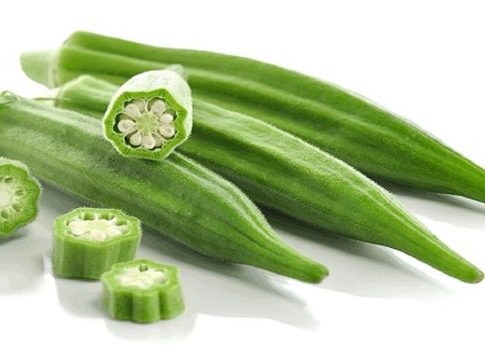Okra, with its fuzzy exterior and star-shaped pods, can be a mystery to some home cooks. But fear not! This veggie is a true culinary chameleon, delicious when roasted, sauteed, stewed, or even fried.
Okra, also known as lady’s finger, is a flowering plant in the mallow family, native to Ethiopia and cultivated in tropical, subtropical, and warm temperate regions around the world for its edible green seed pods. It is a versatile vegetable that can be enjoyed in a variety of dishes, from stews and soups to roasted okra and fried okra tempura.
Health Benefits:
Okra is packed with nutrients and offers several health benefits, including:
- High in Fiber: Okra is an excellent source of dietary fiber, which aids in digestion, promotes gut health, and contributes to feelings of fullness.
- Rich in Vitamins and Minerals: Okra is a good source of vitamins A, C, K, and folate, as well as minerals like magnesium, potassium, and manganese.
- Antioxidant Properties: Okra contains antioxidants that help protect cells from damage caused by free radicals.
- Potential Heart Health Benefits: Some studies suggest that okra may help lower cholesterol levels and reduce the risk of heart disease.
Global Popularity:
Okra is a popular ingredient in cuisines worldwide, with distinct preparations and variations:
- India: Okra is a staple in Indian cuisine, often cooked in curries, stir-fries, and vegetable dishes.
- Middle East: In Middle Eastern cuisine, okra is commonly used in stews, soups, and fried dishes like kibbeh.
- Caribbean: Okra is a key ingredient in Caribbean cuisine, featuring in dishes like gumbo and callaloo soup.
- Southern United States: Okra is a beloved ingredient in Southern cooking, fried, stewed, and pickled.
Okra is a versatile, nutritious, and delicious vegetable that offers a wealth of culinary possibilities. With its unique flavor, texture, and health benefits, okra is a valuable addition to any diet and a culinary adventure waiting to be explored.
Preparing Okra:
Before diving into cooking methods, let’s get prepping. Wash your okra pods thoroughly and trim off the stem ends. You can leave them whole for roasting or stewing, or slice them into rounds or bite-sized pieces for quicker cooking.
Cooking Methods:
- Roasting: Roasting brings out okra’s natural sweetness and caramelizes its edges beautifully. Preheat your oven to 425°F (220°C). Toss okra with olive oil, salt, pepper, and your favorite spices (think garlic powder, smoked paprika, or a cajun blend). Spread the okra in a single layer on a baking sheet and roast for 15-20 minutes, or until tender and golden brown. This method is perfect for a hands-off approach and pairs well with roasted chicken or fish.
- Sauteing: This quick and easy method is perfect for a side dish or adding to salads. Heat oil (olive oil or canola oil work well) in a pan over medium heat. Add sliced onions and cook until softened. Then, add your okra and saute for 5-7 minutes, stirring occasionally, until tender-crisp. Season with salt, pepper, and a squeeze of lemon juice for a fresh touch. For an extra flavor boost, add chopped garlic or a pinch of red pepper flakes along with the onions.
- Stewing: Simmering okra in a flavorful broth is a soul-warming way to enjoy it, especially during colder months. In a pot, heat oil and saute onions, garlic, and your favorite aromatics like thyme or curry powder. Add chopped tomatoes, broth (vegetable or chicken), and your okra. Season with salt, pepper, and herbs. Bring to a boil, then reduce heat and simmer for 20-25 minutes, or until the okra is tender and the stew has thickened slightly. This is a versatile base – you can add other vegetables like corn or green beans, or protein like shrimp or chicken, to create a complete meal.
- Frying: Okra tempura is a classic Southern comfort food, but there are healthier ways to achieve a crispy texture. Pan-frying is a great alternative. Heat a thin layer of oil in a pan over medium-high heat. Dredge your okra pieces in a mixture of beaten egg and breadcrumbs or panko for a crunchy coating. Fry the okra in batches until golden brown and crispy on all sides. Drain on paper towels and serve with your favorite dipping sauce, like a spicy remoulade or a tangy yogurt sauce.
Tips:
- Reduce Slipperiness: Okra can be slightly slimy when cooked. To minimize this, preheat your pan very well before adding the okra and avoid overcrowding the pan. Alternatively, you can toss the okra with a bit of cornstarch or flour before cooking. A light coating helps the okra brown nicely and reduces the amount of slime released.
- Cooking Time: Cooking time can vary depending on the size and desired tenderness of your okra. Keep an eye on it and adjust the cooking time accordingly. For a firmer texture, especially when roasting or sauteing, cook for a shorter time. If you prefer a softer texture, suited for stews or soups, simmer for a longer duration.
With these easy methods, you’re well on your way to enjoying okra in all its glory. So, experiment, have fun, and discover your favorite way to prepare this versatile vegetable! You might even surprise yourself with how much you enjoy this unique and delicious pod.
